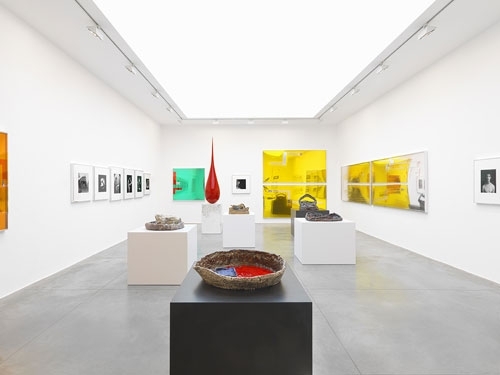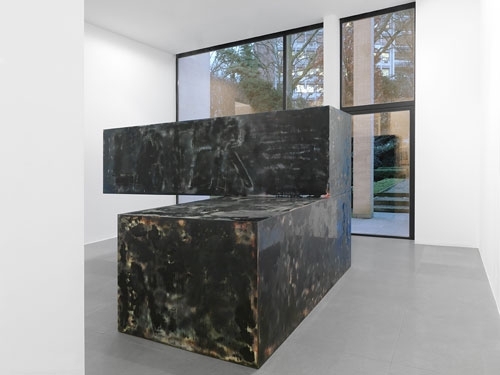Robert Mapplethorpe & Sterling Ruby @ Xavier Hufkens, Brussels
by Travis Jeppesen on January 15, 2010
A very strange exhibition, and one of the best I’ve seen in a long time. The show is actually Ruby’s — or more precisely, Ruby selected photographs of Mapplethrope’s and then made sculptural works responding to them. But Ruby’s work seems to have nothing to do with Mapplethorpe’s at first glance; and the more you look at the two, the more confused you become. I mean, Mapplethorpe’s work is difficult to look at, period, not because of the supposedly “transgressive” content, but because of the wall of discourse that’s been built up around it since the artist’s untimely death. You can’t look at a Mapplethorpe without thinking, “This is a Mapplethorpe,” and most people’s thoughts don’t get much further past that.
To Ruby’s credit, he does not always go for the most obvious images — the ones that all of us have seen time and again — the black cocks and the celebrity portraits and Mapplethorpe shoving things up his butthole. Rather, Ruby has chosen works that are more interesting from a formal perspective, if only accidentally so. It is either ironic or symptomatic of Mapplethorpe’s over-exposure as an artist that the best photograph in the exhibition is devoid of human figures. Texas Gallery, a work from 1980, showcases a single strip of sunlight leaking out from behind a curtain across the floor of an art gallery.
Ruby’s “response” to these works is powerful and disruptive. Whereas Mapplethorpe’s photographs appear to be concrete, offering a direct line towards a simple understanding of each image, Ruby’s work is abstract, bombastic, and not at all easy to understand or look at.
Ruby offers four predominant types of work in the Xavier Hufkens exhibition. The Transcompositional series utilizes different shades of shiny mirror acrylic as canvas and affixes usually one or two small photos of pre- and post-op trannies, then splatters the overall picture (not profusely) with drops of blood red nail polish. This type of work positions itself somewhere between sculpture and painting, or perhaps fits into the ongoing re-definition of painting that has been happening for the last few years (this is the subject of a future piece of writing that I’m working on.) Then, in the first room, you encounter a series of ceramics, which are probably the most outrageous pieces in the show. They look almost excremental — like obscenely long snakey turds someone has tried to weave into baskets, then painted over, only to have them fall in on themselves, collapse into wasteful designs; pools of shiny colorful paint occasionally emerge inside the ceramics; they are sublime.
In a recent inteview, Ruby discussed the influence of Donald Judd on his work, the dogmatism surrounding “pure” minimalism. The proliferation of minimalism and Judd’s writing in art schools today, bordering on indoctrination. How Ruby’s impulse was to simultaneously give in to that dogmatism, to that type of work, while wanting to deface it. The consequences of this impulse have been some of Ruby’s most talked about sculptures to date, several of which are included in the Xavier Hufkens show. Massive wooden blocks, reminiscent of Judd’s metal blocks, only painted on, defaced, with graffiti-esque tags and symbols and AbEx-esque paint splatterings. He takes the language of classical minimalism and deforms it towards his own ends, oftentimes stacking the structures to make them resemble cock and balls, such as the massive (390 x 443 x 122 cm) phallus Headless Dick/Mapplethorpe (2009).
Next to the phallus are twin towers from the Monument Stalagmite series. Constructed out of several media, they look as though they are melting, candle-like. The one is subtitled Visine Dream, while the yellow one is Adultism Pissing. Bodily fluids are referenced throughout the exhibition; they seem to form the dominant motif. Not just blood and shit; two paintings are just white acrylic paint sprinkled across a beige, unreadable surface; they look like cum. These fluids, of course, have an allegorical significance to the sexually charged work of Mapplethorpe, who died of AIDS. But the fluids themselves are missing from the photographs. In a way, one can say that, while Mapplethorpe captured surface transgressions, Ruby’s response has been to take the inside outside and shove it in our faces. Sculpture seems to be the most potent medium for accomplishing this.
This weekend, the show of another artist who died of AIDS opens in Brussels, Felix Gonzalez-Torres. The show is curated by Elena Filipovic, but mid-way through the exhibition, artist Danh Vo will stage a curatorial “remix” of the show. You can’t help but draw comparisons to Ruby’s project. Maybe this is a turn towards a more general trend, the artist-as-curator.







One comment
[…] “In a way, one can say that, while Mapplethorpe captured surface transgressions, Ruby’s response has been to take the inside outside and shove it in our faces.” [x] […]
by Can one have a conversation with an artist who is no longer living? | Designblog on January 7, 2015 at 1:01 pm. #